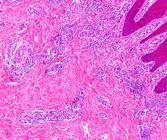ABSTRACT:
Bovine digital dermatitis (BDD) is a polybacterial claw disease that is endemic to dairy cattle kept in loose house systems, and treponemas are the main bacteria implicated in this disease. The objective of this study was to report the occurrence of Treponema spp. in BDD from crossbred dairy cattle (Holstein x Zebu) kept in a pasture in the Brazilian Amazon biome. The diagnostic of BDD was performed by inspecting the distal extremities of cattle during milking in one or more visits comprising 15 farms. In total, it could be inspected 1,847 cows from August 2016 to July 2017, and 25 lesions of BDD were diagnosed. The feet were scored (System M: M0 = no lesion, M1 = ulcer stage <2cm, M2 = ulcer stage >2cm, M3 = healing stage, M4 = chronic stage, M4.1 = chronic stage with ulcer area). Twenty four biopsy samples were taken from feet with BDD and five biopsy samples from feet with no lesions. The histopathology of stained tissues was performed by hematoxylin and eosin and Warthin-Starry method. The samples were also tested by nested PCR for the three previously isolated BDD Treponema phylogroups (T. medium/T. vincentii-like, T. phagedenis-like and T. putidum/T. denticola-like). Spirochetes were observed in 54.2% (13/24) of the lesions, and in 91.7% (22/24) of the samples were detected the DNA of this spirochete belonging to the treponema phylogroups implicated in BDD. In 25% (6/24) of the lesions were detected all the phylogroups. Forty percent (40%, 2/5) of the M0 samples were also positive for the nested Polymerase Chain Reaction (nested-PCR), as 8.3% (2/24) of the lesions were negative in both techniques employed. Treponema putidum/T. denticola-like was the most detected bacterial in all the stages, and active lesions (M2 and M4.1) presented a greater proportion of T. medium/T. vincentii-like and T. phagedenis-like, but no statistical differences were observed (p>0.05). It could be concluded that BDD lesions in crossbred dairy cattle kept to pasture in the Amazon biome were classified as “polytreponemal” infections and the phylogroup T. putidum/T. denticola-like was the most frequent in the lesions.
INDEX TERMS:
Treponema spp.; bovine digital dermatitis; Amazon biome; Brazil; Mortellaro disease; Warthin-Starry; nested-PCR; cattle

 Thumbnail
Thumbnail
 Thumbnail
Thumbnail
 Thumbnail
Thumbnail
 Thumbnail
Thumbnail
 Thumbnail
Thumbnail
 Thumbnail
Thumbnail
 Thumbnail
Thumbnail






